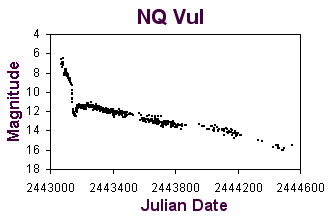NQ Vul (Nova Vulpeculae 1976)
NQ Vul was discovered visually by the English amateur astronomer George Alcock on 1976 October 21 at a magnitude of 6.5 (AAVSO Alert Notices 9, 10, 12, 13). A precusor to the event was seen on photographic plates taken 26 hours before discovery by the Sternberg State Astronomical Institute in Moscow (Carroll 1977).
 |
| Visual light curve of NQ Vul from the AAVSO International Database; August 9, 1976, to December 26, 1980. |
Since 1976, the AAVSO has processed over 4100 observations of NQ Vul. The light curve resembles that of an earlier slow nova, DQ Herculis (Nova Her 1934), in that significant fluctuations are observed in the early stages of the outburst. The light curve of NQ Vul shows that the nova achieved its maximum brightness a couple of weeks after its initial discovery, where it reached a maximum magnitude of about 6.4. From maximum the nova then dropped to magnitude 8.3 within a couple of days. The nova remained around 8th magnitude, but continued to fade a few tenths of a magnitude over the next couple of months. The nova then underwent another episode of fading where it dropped by almost 2 magnitudes within a couple of days. In a last great gasp, the nova then brightened slightly before starting its gradual decline in 1977. The few positive observations in the AAVSO International Database since that time show the nova at 16th magnitude during the 1980s. Further monitoring of this nova is clearly needed, particularly by observers with CCD cameras.

